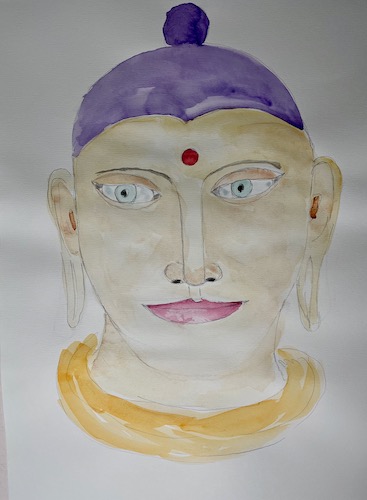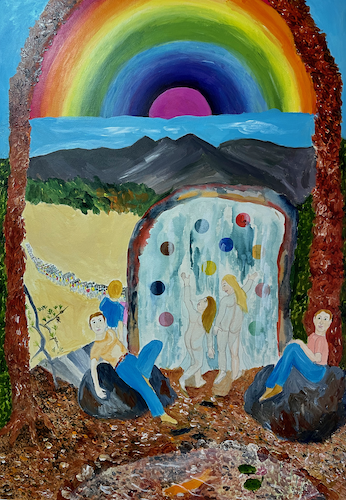zichi Lorentz
![]()
Zichi Lorentz.
Visual Artist.Commentator-Publisher.
Liverpool UK (1952-1971).
London UK (1971-1994).
Japan (1994-).
Present location:Tatsuno City. Hyogo.


Buddha. Watercolor study
Ten Worlds in Buddhism
In Buddhism, the Ten Worlds (十界, Jikkai) represent different states of existence that sentient beings can experience, both in their current life and in their spiritual progression. These worlds are divided into two categories: the Six Lower Worlds (which are more dominated by suffering and illusion) and the Four Higher Worlds (which represent higher states of enlightenment).
The Six Lower Worlds (Dominated by Suffering and Delusion)
1. Hell (Jigokukai - 地獄界) A state of extreme suffering, despair, and rage. Experienced when overwhelmed by hatred, violence, or intense despair. Similar to a "hellish" state of mind caused by anger, depression, or loss.
2. Hunger (Gakikai - 餓鬼界) A state of intense craving and insatiable desire. Represented by greed, addiction, or obsessive longing. Can manifest in material greed, emotional neediness, or an unfulfilled life.
3. Animality (Chikushokai - 畜生界) A state of acting purely on instinct, lacking reason or morality. Characterized by fear, submission to the strong, and domination of the weak. Reflects a survival-driven mentality, like animals reacting without deeper thought.
4. Asura (Shurakai - 修羅界) A state of arrogance, competitiveness, and aggression. Rooted in ego, jealousy, and a constant struggle for superiority. Unlike Animality, there is some awareness, but it is consumed by conflict.
5. Humanity (Ningenkai - 人間界) A state of balance where one can exercise reason and self-control. Characterized by the ability to reflect, choose, and seek growth. While relatively peaceful, it is still subject to suffering and desires.
6. Heaven (Tenkai - 天界) A state of temporary joy and pleasure. Experienced through success, love, or external gratification. However, this state is impermanent and subject to change, leading to eventual suffering.
The Four Higher Worlds (Guided by Enlightenment and Wisdom)
1. Learning (Shōmonkai - 声聞界) A state where one seeks wisdom and truth through study. People in this state are driven by a desire to understand teachings from others. While enlightening, it can sometimes lead to detachment from reality.
2. Realization (Engakukai - 縁覚界) A state of deep self-awareness and insight gained through personal experience. People in this state seek enlightenment through reflection on nature and life’s impermanence. However, like Learning, it may lead to isolation or a lack of compassion for others.
3. Bodhisattva (Bosatsukai - 菩薩界) A state of compassion, altruism, and dedication to helping others achieve enlightenment. Represents selfless service and a desire to bring happiness to all beings. This state is one step away from Buddhahood but still requires effort.
4. Buddhahood (Bukkai - 仏界) A state of ultimate wisdom, peace, and enlightenment. Beyond suffering, it embodies boundless compassion, courage, and clarity. Unlike Heaven, this is a permanent state that can be experienced in daily life through spiritual awakening.
Key Concepts of the Ten Worlds Mutual Possession of the Ten Worlds
Each world contains all ten within it, meaning a person can shift between these states at any moment.
Potential for Buddhahood Everyone has the inherent ability to reach enlightenment regardless of their current state.
Practice and Growth Through Buddhist practice (such as chanting, meditation, and good deeds), one can elevate their state toward Buddhahood.
Video on the Ten Worlds